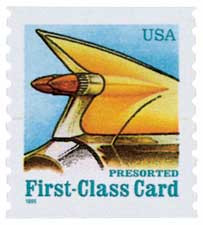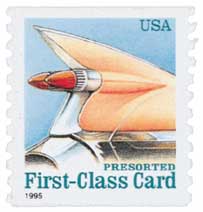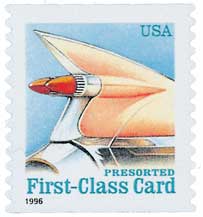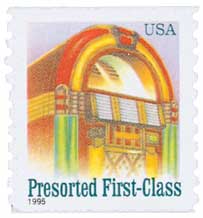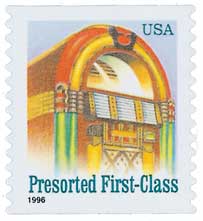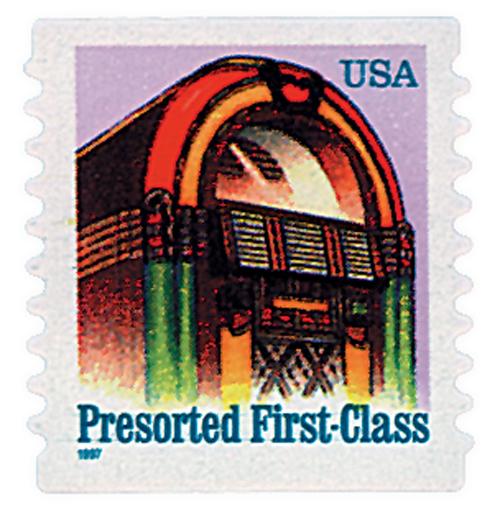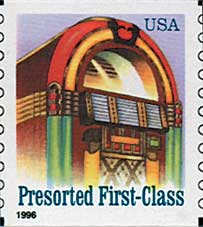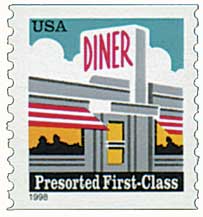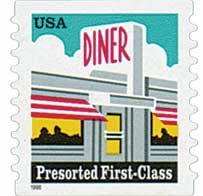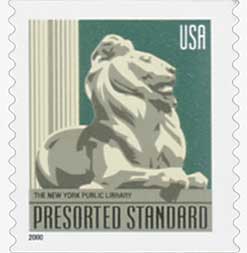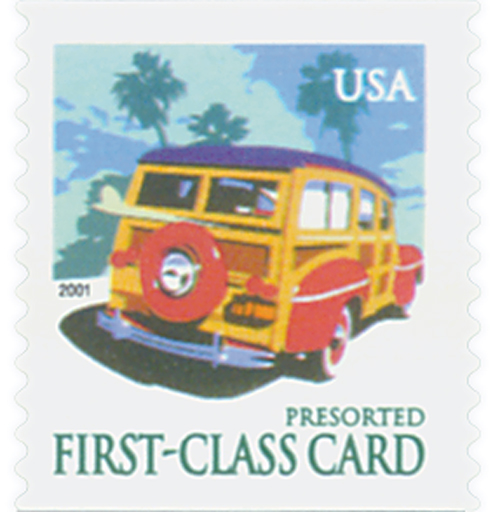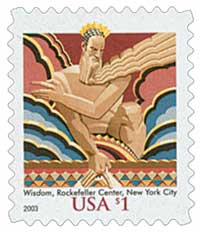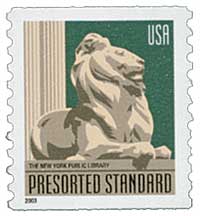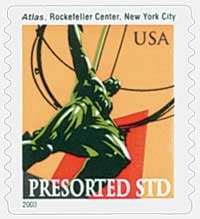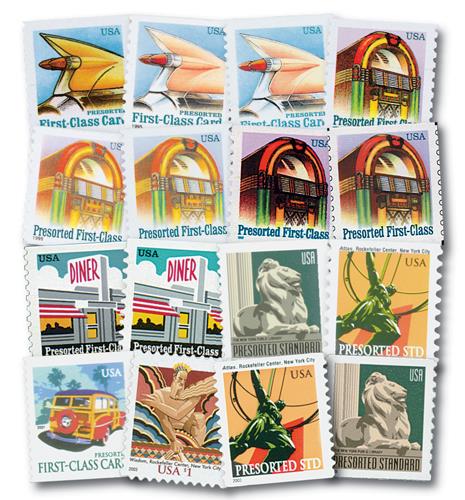
# 3522 - 2001 15c Woody Wagon, coil
15¢ Woody Wagon
American Culture Series
City: Denver, CO
Printed by: American Packaging Corporation for Sennett Security Products
Printing Method: Photogravure
Perforations: Serpentine Die Cut 11 ½ vertically
Color: Multicolored
American Culture Series
The stamps in this series were issued in part to meet a new postal rate structure that had been implemented on January 1, 1995. These new rates included a variety of bulk mail discounts, which these stamps were used for.
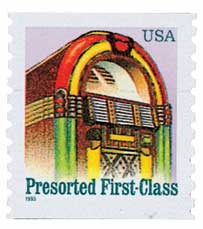
Under the new rate structure, bulk discounts were offered on the basic 20¢ postcard rate, ranging from 16.3¢ to 18.9¢. Mailers could use the new 20¢ Tail Fin stamp and then pay the difference between what they spent on the stamps and the actual cost of mailing.
This new structure also included a discount off the basic 32¢ first-class rate that ranged from 21.2¢ to 30.5¢. The new 25¢ Jukebox stamp could be used on these envelopes, with the mailers paying or receiving credit for the per-piece difference in postage between the stamp price and the actual cost of the postage. It was used in place of the G-rate stamp and replaced the 23¢ presort rate stamps from 1992 and 1993.
The new 20¢ and 25¢ stamps would be the first issues in the new American Culture Series. In planning the series, the USPS wanted stamps to picture artifacts of America’s popular culture. According to the USPS, “The series tries to take a look at American creativity and at things no other country could claim.” In planning the series, the USPS created a list of items from post World War II America to consider. One USPS official said, “I look on the era of the ’40s and ’50s as a very creative one, and one with a lot of recognizable symbols that have never been on stamps.”
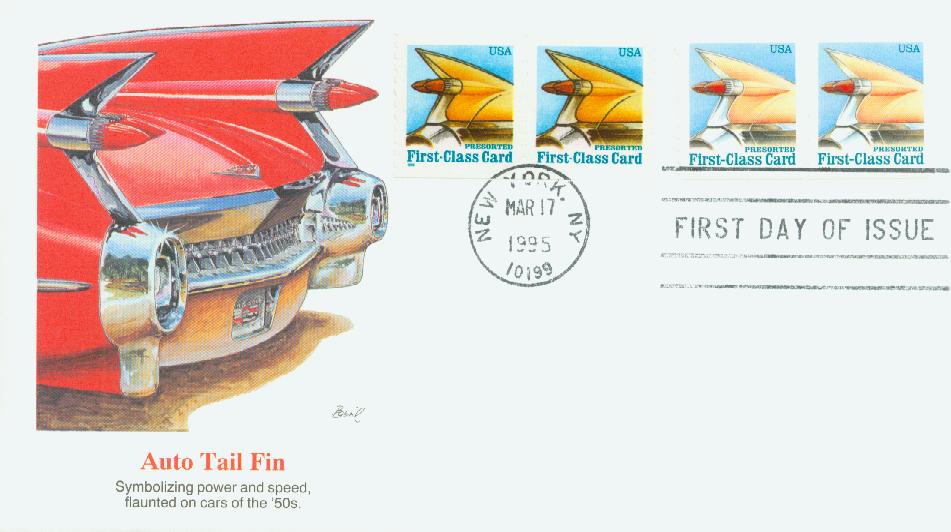
On March 17, 1995, the American Culture Series stamps made their debut at the Postage Stamp Mega-Event at Madison Square Garden in New York City. The two stamps were non-denominated coils for price-discounted bulk mail. The 15¢ stamp picturing an auto tail fin was issued for presorted first-class postcards. The 25¢ jukebox stamp would be used on presorted first-class letter mail.
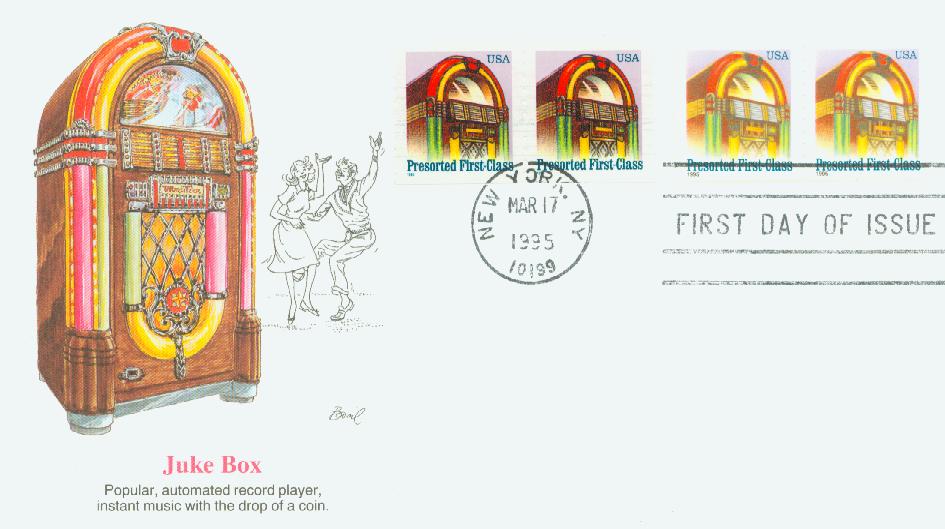
Both stamps were produced by two different printers, so there were two varieties of each stamp made available that day. The stamps printed by the BEP have the year printed smaller in an aqua color, while the Stamp Venturers’ have the date larger and black.
The American Culture Series continued until 2003, with a total of 16 stamps issued. Click on the other images below to learn more about them and to order them for your collection.
15¢ Woody Wagon
American Culture Series
City: Denver, CO
Printed by: American Packaging Corporation for Sennett Security Products
Printing Method: Photogravure
Perforations: Serpentine Die Cut 11 ½ vertically
Color: Multicolored
American Culture Series
The stamps in this series were issued in part to meet a new postal rate structure that had been implemented on January 1, 1995. These new rates included a variety of bulk mail discounts, which these stamps were used for.

Under the new rate structure, bulk discounts were offered on the basic 20¢ postcard rate, ranging from 16.3¢ to 18.9¢. Mailers could use the new 20¢ Tail Fin stamp and then pay the difference between what they spent on the stamps and the actual cost of mailing.
This new structure also included a discount off the basic 32¢ first-class rate that ranged from 21.2¢ to 30.5¢. The new 25¢ Jukebox stamp could be used on these envelopes, with the mailers paying or receiving credit for the per-piece difference in postage between the stamp price and the actual cost of the postage. It was used in place of the G-rate stamp and replaced the 23¢ presort rate stamps from 1992 and 1993.
The new 20¢ and 25¢ stamps would be the first issues in the new American Culture Series. In planning the series, the USPS wanted stamps to picture artifacts of America’s popular culture. According to the USPS, “The series tries to take a look at American creativity and at things no other country could claim.” In planning the series, the USPS created a list of items from post World War II America to consider. One USPS official said, “I look on the era of the ’40s and ’50s as a very creative one, and one with a lot of recognizable symbols that have never been on stamps.”

On March 17, 1995, the American Culture Series stamps made their debut at the Postage Stamp Mega-Event at Madison Square Garden in New York City. The two stamps were non-denominated coils for price-discounted bulk mail. The 15¢ stamp picturing an auto tail fin was issued for presorted first-class postcards. The 25¢ jukebox stamp would be used on presorted first-class letter mail.

Both stamps were produced by two different printers, so there were two varieties of each stamp made available that day. The stamps printed by the BEP have the year printed smaller in an aqua color, while the Stamp Venturers’ have the date larger and black.
The American Culture Series continued until 2003, with a total of 16 stamps issued. Click on the other images below to learn more about them and to order them for your collection.











